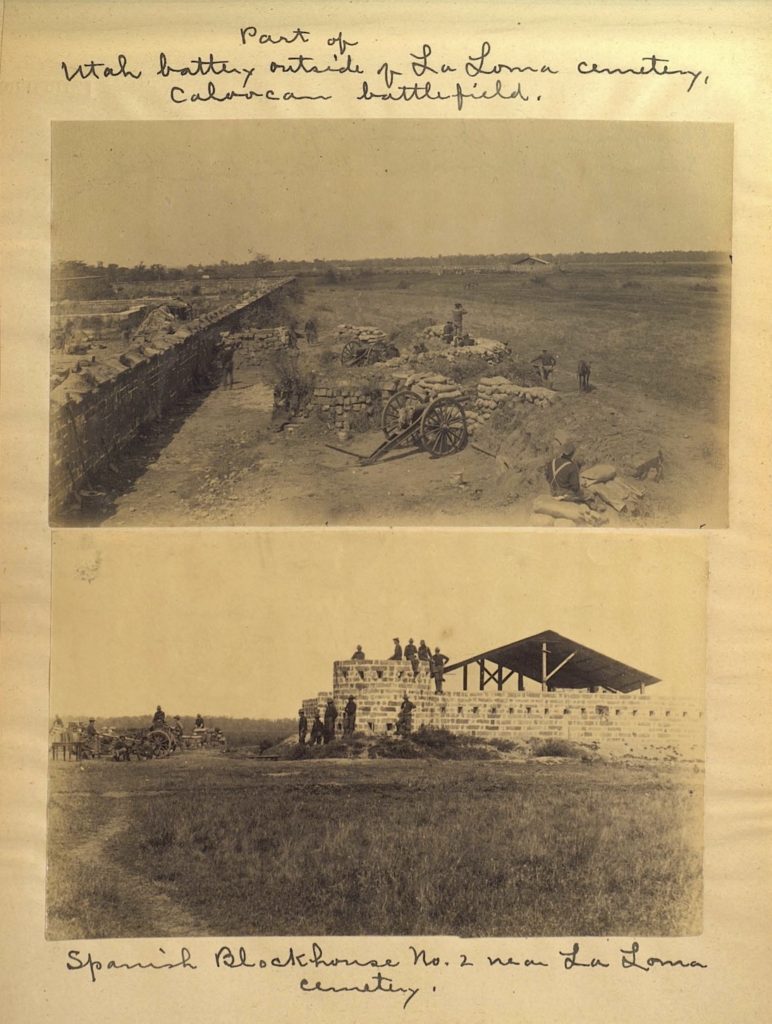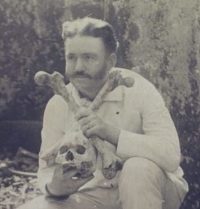Caloocan Battlefield — Entry made in the ex-Spanish fort or stone blockhouse* (*Note. Blockhouse No. 2 at La Loma) — Feb. 8th, 6.20 p.m.
A day of exciting events. Got up as usual starting with Bible reading and prayers. Cooked breakfast, then straightened up my rooms with a view to leaving for a few days if considered best. About 10. o’clock a.m. with my blanket, diary, soap, towel, one pair socks, 4 photographic films, one loaf bread, 3 cans devilled ham, & 1 of jelly & a pocket filled with peanuts, I struck out on foot. Brought my umbrella along for contingencies of rain & hot sun. Rev. Chas Owens and wife accompanied me on foot. Went out thro’ the native quarter on Dulumbayan street. A carromata driven by a Filipino came along with a 10th Pennsylvania soldier on board. Mrs. Owns was taken on & put off at the large Spanish Roman Catholic mortuary chapel in the Binondo or La Loma cemetery. This cemetery on the hill including the Chinese burying place is an immense affair. Name: Cemeterio de la Parroquia de Binondo.”
Owens and I walked out. Arrived on the battleground about 11 o’clock. Sharp shooting with an occasional volley was kept up all day until 5 p.m. in a disultory manner. In the forest to the left skirting the bay just outside of Caloocan, the American battle line lay across the pain with its left wing on the bay near Caloocan & the right wing miles away. I went along the battle line for quite a distance visiting the batteries (particularly H and K) of the 3d Reg’t heavy artillery & the Montana infantry. Met quite a number of acquaintances as saved & unsaved. Seemed glad to meet me. Brought the matter of salvation personally to the attention of a number of soldiers. The boys were very hospitable offering me such food as they have on the battlefield & coffee.
Brigadier General Otis was on the field taking in the situation personally.
During the early part of the afternoon I witnessed an interesting skirmish down on the open flat field north east of the Spanish mortuary chapel. Three men went down to fire some native huts. The enemy would have probably captured them, had not 15 men went out to support them. The firing on both sides was quite brisk for a time. The Filipinos lay in the shelter of timber & the Americans in the open, but none of the latter were hurt.
5 p.m. The shooting in the forest west of us became hot. Brisk work. A war vessel (probably “Concord”) out in the bay threw shells in the town & 2 Utah pieces over on our hill assisted. The attacking party (20th Kansas Infantry less Co. G) could not be seen from the forest but their advance could be traced by the line of burning buildings as they advanced into Caloocan. In half an hour the town was taken. As darkness closed in I went over to the battle line — 3d artillery. The boys gave me some coffee which with my loaf of bread served me for supper. By the light of the burning village I managed to pick my way over the small brook at the bottom of the hill to the Spanish blockhouse (No. 2) or fort. A wall about 10 feet high punctured with numerous port holes for small arms with a shelf to stand on around the inside, & a wood frame covered with corrugated iron is the aforesaid blockhouse. Company G, 20th Kansas vol. infantry (Capt. Elliot) occupied the same: also a detachment of Utah light artillerymen. I laid a piece of heavy paper on the ground, my blanket on the same & using my coat for a pillow considered myself fortunate. While lying there, availed myself of an opportunity the Lord gave me, to talk to a corporal lying alongside me of salvation.
My bed was pretty hard. Slept in my clothes.
Caloocan is a village on the Dagupan railroad about one and a half miles from Malibon [Malabon].
Our battle line remained in place all night sleeping on their arms. Nothing unusual happened during the night save the occasional firing of our pickets.

